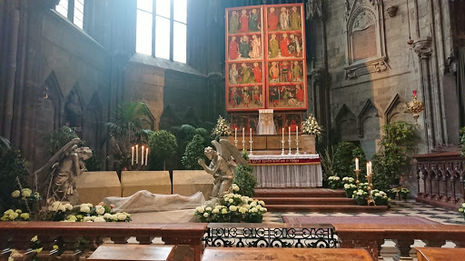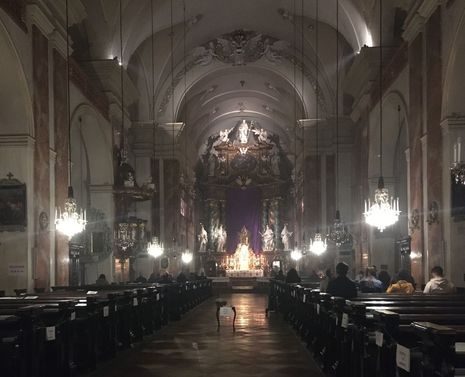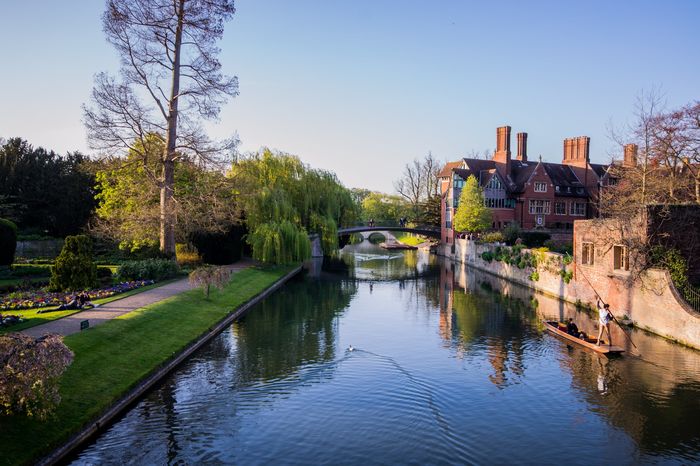An Easter far from home
Stuck in Vienna over Easter, Anna Whitehead embraces ancient and unfamiliar traditions

If there’s one thing doing a Year Abroad during a pandemic has taught me, it’s to prepare to be unprepared. No matter how many meticulous spreadsheets I might make, mutant virus strains, ever-changing travel restrictions and the whim of Sebastian Kurz are all inevitably out to scupper my plans. With a trip back home for the Easter weekend therefore as impossible as finding Hot Cross Buns in Austria, my Catholic flatmates and I were faced with the prospect of spending the most important days of our year away from home.
What would a Holy Week away from the comforts and customs of the family home look like? What was essential for us, and where were we willing to compromise? We found that such decisions brought with them not only a sense of freedom, but also a feeling of responsibility. Instead of just trailing along with our families to our local parishes, we were actively deciding to participate in the Holy Triduum, and so writing ourselves into the story of the Churches we visited, and into the thousand-year-old traditions of our faith.
The first day of the Triduum is Maundy Thursday, or Gründonnerstag as it is called in German-speaking world. There are various suggestions as to why – some propose that ‘Grün’ comes from the German verb ‘Greinen’, to lament, while others maintain that it is indeed ‘Green’ Thursday. The practice of eating particularly verdant vegetables on the day can be traced back to the 14th Century. After dutifully eating a spinach puree that belonged in a millennial detox boot camp, we headed off for a more traditional Mass at the Rochuskirche, and as soon as I could smell the incense wafting out down the street, I knew we wouldn’t be disappointed.
“What would a Holy Week away from the comforts and customs of the family home look like? What was essential for us, and where were we willing to compromise?”
The Maundy Thursday Mass commemorates the Last Supper which Jesus shared with his disciples, and is especially meaningful for Catholics, who believe that it is through the breaking and sharing of the bread that Jesus instituted the Eucharist; the ‘source and summit of the Christian life’. The priest normally washes the feet of willing volunteers, re-enacting Jesus washing the feet of his disciples, but it turns out that while washing hands is highly recommended, washing feet is too high of a Covid-19 risk. After Mass we made our way to the Cathedral, Stephansdom, to find a chapel filled with plants, in an attempt to recreate the atmosphere of the Garden of Gethsemane, where Jesus went to pray after the Last Supper. The benches were filled with contemplative Viennese Catholics, reflecting on Jesus’ impending arrest and crucifixion.
I’ve always found the second day of the Triduum, Good Friday, challenging. But for there to be an Easter Sunday there must be a Good Friday which comes before it, and if this year was particularly difficult it was because I was forced to dig a little deeper. In hindsight, the four-hour near-vertiginous hike ending with a two-hour chanted service was largely responsible for this. The surprise of the seasoned hikers we encountered in the first ten minutes, as well as their attire and walking poles, was probably when I realised that the walk ahead would be a little more strenuous than I had initially thought. After following misleading signposts through dense patches of woodland, fields, villages and up forbiddingly steep inclines, I was relieved to see the bell tower of Heiligenkreuz rising through the overcast skies. The weather was so dramatic that I did take my mind off my aching feet by imagining I was a small figure in a German Romantic landscape painting.

Stift Heiligenkreuz is the oldest continuously occupied Cistercian monastery in the world and has a relic of the True Cross of Jesus, presented by Leopold V in 1188. Leaving my scepticism about the authenticity of such a relic outside as I entered the Chapel, I thought about how Jesus’ disciples felt, seeing their master and friend being led to his death. With daily updates on the Covid-19 death toll and the tragic loss of many loved ones, the pandemic has confronted us all with the stark reality of death over the past year. A particularly painful loss for the Catholic community in Cambridge has been that of our much-loved Chaplain at Fisher House, Father Mark Langham, who passed away in January. Shivering under the stone vaults and staring at the vacant tabernacle, feelings of grief and emptiness returned. The void which death seems to be, and which it leaves behind, felt very real and close to heart indeed.
One of the most moving moments of live-streamed Holy Week last year was Father Mark singing the Exsultet at the Easter Vigil, and although the sound quality was patchy, the strength of his voice, and the majesty and clarity of the message he was proclaiming, remained undiminished. Listening to the Exsultet at the Stephansdom Easter Vigil was therefore a poignant moment. Putting aside the sad thought that I wouldn’t be able to email Father Mark to tell him all about the fine vestments and music, which I knew he would have loved, I tried to focus on understanding what was happening before me.
A fire being lit by Cardinal Schönborn, candlelight spreading gradually through the darkness, the sound of the Cathedral’s bells ringing out through the Viennese night, an old Austrian man belting out an Alleluia: Jesus conquering death and bringing light to the world. We had reached the pinnacle – the reason why I’m a Catholic and the reason which gives me hope and joy to live each day by. Easter in Vienna might have looked different to an Easter at home, but through the differences and the difficulties, the message remains unchanged, for as St Pope John Paul II said, “[w]e are an Easter people and Alleluia is our song”.
 News / Eight Cambridge researchers awarded €17m in ERC research grants27 December 2025
News / Eight Cambridge researchers awarded €17m in ERC research grants27 December 2025 News / Clare Hall spent over £500k opposing busway 24 December 2025
News / Clare Hall spent over £500k opposing busway 24 December 2025 Comment / League tables do more harm than good26 December 2025
Comment / League tables do more harm than good26 December 2025 Comment / The ‘class’ of Cambridge24 December 2025
Comment / The ‘class’ of Cambridge24 December 2025 News / Caius mourns its tree-mendous loss23 December 2025
News / Caius mourns its tree-mendous loss23 December 2025









